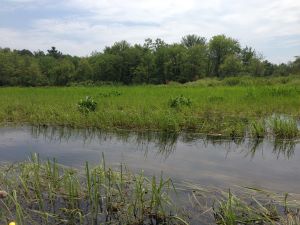Permit Review
Resources for LACs and LRSs reviewing permit applications
A major duty of the LACs and LRSs is to review and comment on local, state or federal plans and permit applications for activities within the designated river corridor as described in RSA 483:8-a III(b). RMPP staff email a weekly permit notification to LAC and LRS chairs and staff containing the Wetlands, Shoreland and Alteration of Terrain permit applications received by NHDES over the prior week. Other types of permits and funding applications are less common and are sent to LAC and LRS chairs and staff separately.
 Under the Shoreland Water Quality Protection Act (RSA 483-B), permits are required to build within the protected shoreland (250' from the reference line of public waterbodies).
Under the Shoreland Water Quality Protection Act (RSA 483-B), permits are required to build within the protected shoreland (250' from the reference line of public waterbodies).
 Wetlands are important resources that protect water quality, provide flood control and offer critical habitat for many species. Excavation, fill, dredging and construction of structures in or on banks, flats, marshes, forested wetlands, or permanent waterbodies are subject to permit requirements under RSA 482-A. LACs and LRSs review wetland permit applications for projects expected to have more than minimum impact.
Wetlands are important resources that protect water quality, provide flood control and offer critical habitat for many species. Excavation, fill, dredging and construction of structures in or on banks, flats, marshes, forested wetlands, or permanent waterbodies are subject to permit requirements under RSA 482-A. LACs and LRSs review wetland permit applications for projects expected to have more than minimum impact.
 Permits are required for projects that propose to disturb more than 100,000 square feet of contiguous terrain (or 50,000 square feet if any portion of the project is within a protected shoreland). Disturbances greater than 2,500 square feet, over terrain with grades of greater than 25%, may also require these permits. AoT "General Permits by Rule" apply to smaller sites which do not require applications or notifications.
Permits are required for projects that propose to disturb more than 100,000 square feet of contiguous terrain (or 50,000 square feet if any portion of the project is within a protected shoreland). Disturbances greater than 2,500 square feet, over terrain with grades of greater than 25%, may also require these permits. AoT "General Permits by Rule" apply to smaller sites which do not require applications or notifications.
- Alteration of Terrain Program.
- Permit lookup: NHDES OneStop.
- Rare and listed species resources: New Hampshire Natural Heritage Bureau.
- AoT list of best management practices.
The following permits are subject to LAC review if the proposed project site is within 250 feet of a designated river.
- Underground storage tank (UST) and aboveground storage tank (AST) permits: Underground and aboveground storage tank permits aim to prevent and minimize water and land contamination through proper storage of heating oils, hazardous substances, lubricating oils, motor fuels and other petroleum or contaminated liquids.
- Herbicide and pesticide permits: Herbicides and pesticides may only be applied within 50 feet of the reference line of a designated river by an applicator licensed by the New Hampshire Department of Agriculture, Markets and Food with a special permit issued by the agency.
- Hazardous waste permits: Four types of hazardous waste permits are issued by NHDES for either solid or liquid wastes. LACs are most often asked to review hazardous wastewater permit applications which regulate how hazardous waste generators handle and treat their wastewater before it is transferred from its source to a wastewater treatment facility.
- Solid waste permits: Solid waste permits assure proper construction, operation and closure of solid waste facilities in order to protect the environment and public health and safety. Solid waste permits are scaled by the number of tons of waste accepted by the facility. Research and development permits are also required.
- Dam permits: Dam permits are required for the construction, removal, repair or reconstruction of dams and hydro-electric production facilities.
- National Pollutant Discharge Elimination System (NPDES) permits: Any facility that discharges directly to a surface water is required to obtain a federal NPDES permit. Individual NPDES permits reflect site-specific conditions of a single discharger, while general NPDES permits cover multiple dischargers with similar operations and types of discharges. This permit is administered by the EPA and certified by NHDES.
The following are state managed funds for which LACs and LRSs may comment on applications for projects within their river corridors:
- State Revolving Fund (SRF) loans: The SRF loan programs support drinking water safety, water quality and public health through low-cost financial assistance provided by the Environmental Protection Agency (EPA). SRF project applications include an Environmental Review document on which LACs and LRSs may submit concerns through RMPP staff.
- Aquatic Resource Mitigation (ARM) Fund: The ARM Fund allows for permittees to make payments in lieu of mitigation when there are unavoidable impacts to streams and wetlands from permitted activities. Funds are then pooled geographically and made available as competitive grants for restoration, enhancement and preservation activities.
-
Ammonoosuc River
-
Ashuelot River
-
Cocheco River
-
Cold River
-
Connecticut River
-
Contoocook and North Branch Rivers
-
Exeter-Squamscott River
-
Isinglass River
-
Lamprey River
-
Mascoma River
-
Merrimack River (Lower)
-
Merrimack River (Upper)
-
Oyster River
-
Pemigewasset River
-
Piscataquog River
-
Saco River
-
Souhegan River
-
Swift River
-
Warner River



